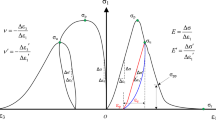Abstract
Uniaxial or triaxial compression test of cylindrical rock specimens using rock mechanics testing machine is a basic experimental method to study the strength and deformation characteristics of rock and the development process of rock fracture. Extensive literature review has been conducted on this issue; meanwhile, experimental and numerical studies have been conducted on the stress-drop effect on the brittleness of rock materials. A plastic flow factor of λ is proposed to describe the stress-drop effect. Evaluation methods of the factor λ corresponding to the four yield criteria of rock mass are proposed. Those four yield criteria are Tresca criterion, von-Mises criterion, Mohr-Coulomb criterion and Drucker-Prager criterion. For simplicity purposes, an engineering approximation approach has been proposed to evaluate the stress-drop with a non-zero strain increment. Numerical simulation results validated the effectiveness of the plastic flow factors λ as well as the engineering approximation approach. Based on the results in this study, finite element code can be programmed for brittle materials with stress-drop, which has the potential to be readily incorporated in finite element codes.
摘要
利用岩石力学试验机对圆柱岩石试样进行单轴和三轴压缩试验, 是研究岩石强度和岩石裂隙发 展过程的基本试验方法。针对岩石材料应力降效应的问题, 首先进行了广泛的文献调研; 然后, 分别 利用室内试验和数值模拟的方法, 研究了应力陡降效应对岩石类材料脆性特征的影响。为了描述应力 降效应, 本文提出了塑性流变因λ, 且基于Tresca 准则、Von-Mises 准则、Mohr-Coulomb 准则和Drucker-Prager 准则等四类岩体屈服准则, 对塑性流变因子λ 进行了评价。此外, 为了简便, 在非零应变增量 下, 提出利用工程近似方法研究应力降。研究结果表明: 数值模拟和工程近似方法均验证了塑性流变 因子的有效性; 脆性材料的应力降, 可以通过有限元代码编码实现, 且该代码可以与原有限元代码简 单有效融合。
Similar content being viewed by others
References
TARASOV B, POTVIN Y. Universal criteria for rock brittleness estimation under triaxial compression [J]. International Journal of Rock Mechanics and Mining Sciences, 2013, 59(4): 57–69.
LABUZ J F, BIOLZI L. Experiments with rock: Remarks on strength and stability issues [J]. International Journal of Rock Mechanics & Mining Sciences, 2007, 44(4): 525–537.
YANG Sheng-qi, JING Hong-wen, WANG Shan-yong. Experimental investigation on the strength, deformability, failure behavior and acoustic emission locations of red sandstone under triaxial compression [J]. Rock Mechanics and Rock Engineering, 2012, 45(4): 583–606.
WONG Teng-fong, BAUD P. The brittle-ductile transition in porous rock: A review [J]. Journal of Structural Geology, 2012, 44(11): 25–53.
WU Qiu-hong, LI Xi-bing, TAO Ming, DONG Long-jun. Conventional triaxial compression on hollow cylinders of sandstone with various fillings: Relationship of surrounding rock with support [J]. Journal of Central South University, 2018, 25(8): 1976–1986.
ZENG Wei, YANG Sheng-qi, TIAN Wen-ling, KAI Wen. Numerical investigation on permeability evolution behavior of rock by an improved flow-coupling algorithm in particle flow code [J]. Journal of Central South University, 2018, 25(6): 1367–1385.
XU Xiao-li, KARAKUS M, GAO Feng, ZHANG Zhi-wen. Thermal damage constitutive model for rock considering damage threshold and residual strength [J]. Journal of Central South University, 2018, 25(10): 2523–2536.
KAHRAMAN S. Correlation of TBM and drilling machine performances with rock brittleness [J]. Engineering Geology, 2002, 65(4): 269–283.
ALTINDAG R. The evaluation of rock brittleness concept on rotary blast hole drills [J]. Journal of the Southern African Institute of Mining and Metallurgy, 2002, 102: 61–66.
GONG Qiu-ming, ZHAO Jian. Influence of rock brittleness on TBM penetration rate in Singapore granite [J]. Tunnelling and Underground Space Technology, 2007, 22: 317–324.
ALTINDAG R. The role of rock brittleness on analysis of percussive drilling performance [C]// Proceedings of 5th National Rock Mechanics. Turkish, 2000: 105–112.
HAJIABDOLMAJID V, KAISER P. Brittleness of rock and stability assessment in hard rock [J]. Tunneling and Underground Space Technology, 2003, 18(1): 35–48.
COPUR H, BILGIN N, TUNCDEMIR H, BALCI C. A set of indices based on indentation tests for assessment of rock cutting performance and rock properties [J]. Journal of the Southern African Institute of Mining and Metallurgy, 2003, 103(9): 589–599.
JARVIE D M, HILL R J, RUBLE T E POLLASTRO R M. Unconventional shale-gas systems: The Mississippian Barnett Shale of north-central Texas as one model for thermo genic shale-gas assessment [J]. AAPG Bull, 2007, 91(4): 475–499.
MISKIMINS J L. The impact of mechanical stratigraphy on hydraulic fracture growth and design considerations for horizontal wells [J]. Bulletin, 2012, 91: 475–499.
RICKMAN R, MULLEN M, PETRE J, GRIESER W V, KUNDERT D. A practical use of shale petro-physics for stimulation design optimization: all shale plays are not clones of the barnett shale [C]// Presented at the SPE Anuual Technical Conference and Exhibition. Denver, Colorado, 2008, September. SPE-115258.
SUORINENI F T, CHINNASANE D R, KAISER P K. A procedure for determining rock-type specific Hoek-Brown brittle parameters [J]. Rock Mechanics Rock Engineering, 2009, 42(6): 849–881.
WANG F P, GALE J F W. Screening criteria for shale-gas systems [J]. Gulf Coast Association of Geological Societies Transactions, 2009, 59: 779–793.
YAGIZ S. Assessment of brittleness using rock strength and density with punch penetration test [J]. Tunneling and Underground Space Technology, 2009, 24(1): 66–74.
ALTINDAG R. Assessment of some brittleness indexes in rock drilling efficiency [J]. Rock Mechanics Rock Engineering, 2010, 43(3): 361–370.
TARASOV B G, POTVIN Y. Absolute, relative and intrinsic rock brittleness at compression [J]. Mining Technology, 2012, 121(4): 218–225.
TARASOV B G, POTVIN Y. Universal criteria for rock brittleness estimation under triaxial compression [J]. International Journal of Rock Mechanics and Mining Science, 2013, 59(4): 57–69.
MENG Fan-zhen, ZHOU Hui, ZHANG Chuan-qing, XU Rong-chao, LU Jing-jing. Evaluation methodology of brittleness of rock based on post-peak stress-strain curves [J]. Rock Mechanics Rock Engineering, 2015, 48(5): 1787–1805.
JIN Xiao-chun, SHAH S N, ROEGIERS J C, ZHANG Bo. An Integrated petrophysics and geomechanics approach for fracability evaluation in shale reservoirs [J]. SPE Journal, 2015, 20(3): 518–526.
RYBACKI E, MEIER T, DRESEN G. What controls the mechanical properties of shale rocks? -Part II: Brittleness [J]. Journal of Petroleum Science and Engineering, 2016, 144(8): 39–58.
Author information
Authors and Affiliations
Corresponding authors
Additional information
Foundation item
Projects(51678083, 41302226) supported by the National Natural Science Foundation of China
Rights and permissions
About this article
Cite this article
Shi, Gc., Chen, G., Pan, Yt. et al. Stress-drop effect on brittleness evaluation of rock materials. J. Cent. South Univ. 26, 1807–1819 (2019). https://doi.org/10.1007/s11771-019-4135-2
Received:
Accepted:
Published:
Issue Date:
DOI: https://doi.org/10.1007/s11771-019-4135-2




